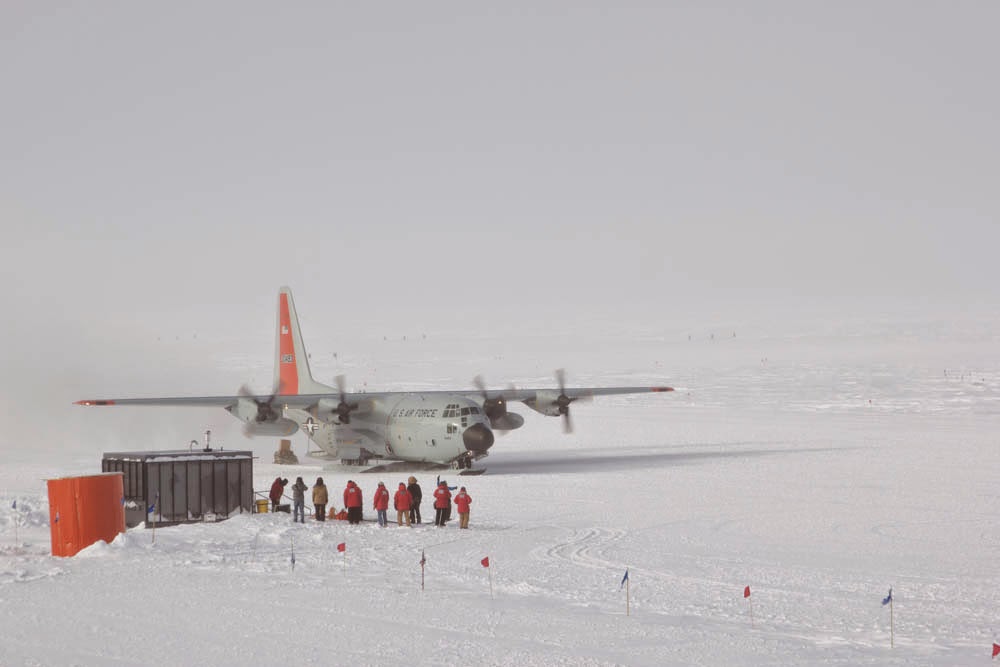Aurora at the South Pole are a big deal for some, while others are indifferent. It's all to easy to stop caring about aurora after seeing the first few. Nevertheless, those who like to race outside to take photos whenever aurora are active (like myself) have several tools to scan the sky and spread the word. Determining when aurora are active is important because the station is completely boarded up to avoid light pollution, so you can only check for aurora by going outside. Since people tend to avoid the cold as much as possible, some tools for catching aurora and spreading the word are necessary.
First is the Aurora Channel on the radios everyone carries. Hand-held walkie talkies are supposed to be carried at all times. They contain channels for the emergency response team you are assigned to (such as 'Medical' or 'Fire Team'), work based channels (such as 'Comms' or 'Operations'), an 'All Call' channel for station announcements during emergencies, individual channels for specific people, and the Aurora Channel. The radios can also receive pager alerts, so mine receives an alert when something is wrong with the telescope. For the Aurora Channel, when people see a good aurora they will simply make a call over that channel and alert everyone who opted-in to the channel.
The second tool that has been up since the start of the season is the MAPO Aurora Cam. This has been up since the start of the winter and is mounted around the MAPO building in the Dark Sector. Because it is just a webcam, the sensitivity is low. It is useful for seeing bright aurora, as seen in the photo. However, it would miss fainter aurora that aren't as nice to the eye but are still worth of being photographed. The photos are updated every 10 seconds or so and output onto the station intranet, and also rotate through the galley scroll.
This season a third tool was installed, which grabs the most recent NOAA space weather prediction center plot of the current auroral oval. This is also output to the station intranet / galley scroll. When there is high activity over the south pole, then supposedly there should be good aurora outside. However, auroras at the pole don't seem to correlate that well with the auroral oval, and sometimes photographable aurora are seen even when the oval activity is low.


The fourth tool was just installed this week, and is the result of a project I've been working on. Because the MAPO Cam had low sensitivity, and couldn't detect fainter aurora, I refitted the station's very old Canon 1D Mark II camera to be used in an unused roof port. The roof windows are located on the mezzanine of the B2 Science Lab, and all but one house scientific instruments and aurora cameras that the winter Aurora Tech keeps in operation. Because no light should be output from the port, I draped a light shield around the port that contains the camera. Because of the age of the Canon 1D Mk II, it had to be linked to a 32-bit Windows XP computer, which uses canon software to remotely control the camera and send the files out. The camera takes a 30 second ISO 1600 exposure every 5 minutes (any faster time seems to overload the poor old camera) and the photos are posted on the station intranet and galley scroll.
New Aurora Cam Station on the B2 Science Mezzanine
The Canon 1D Mk II looking out a rooftop window
Despite its age, the still shots provide a better picture of what the conditions are outside. In the picture the milky way is visible and a faint aurora can be seen forming on the horizon. Future polies should be able to easily reproduce the setup, although I'd recommended bringing down a better camera specifically for the purpose of aurora detection.
Sample New Aurora Cam Shot
B2 Science
For further reference, I include a shot above of the B2 Science Lab. The section to the right is the SPT workspace where I work when I'm not at the telescope. To the left of that is the Ice Cube work space, and to the left of that is a large cubicle for the meteorology people. Not shown is an area further to the right where the Lockheed science techs work. This area is on the second floor of the station, allowing access to the roof through the mezzanine.
Extras:
- Auroras are often spotted by smokers undeterred by the > 11,000 ft altitude and frigid < -70 F temperatures
- A 'Mastrubatorium' sign was jokingly taped to the aurora cam light shroud because polies in general are excessively clever and cannot contain themselves
- This year has only been average overall for auroras, and the sun will be headed into a solar minimum for future seasons
- Because of our position in relation to the auroral oval, the best auroras are between 10 am and 2 pm, with a secondary peak between 10 pm and 2 am.
- This year has only been average overall for auroras, and the sun will be headed into a solar minimum for future seasons
Next week in Pole: Which direction does water drain at the south pole?



















































